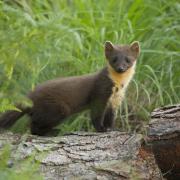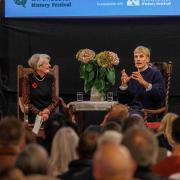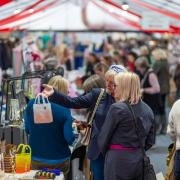Insects have intimate relationships with plants, with some dependent on a particular species to complete their life cycle. Not only do these plants provide a source of food, such as nectar and pollen, for adult insects, but they are also used as larval host plants. This means that larvae have been recorded feeding on these plants in the wild, and can generally complete their development into an adult insect on such a plant (or plants – sometimes more than one species is used). A wide variety of organic matter is consumed by the larvae, including flowers, seeds, roots, and leaves.

Kidney vetch + small blue butterfly
Many insects are solely dependent on one type of plant: if we lose the plant, we lose the insect. A good example in Gloucestershire is our smallest species of butterfly, the small blue. The larvae feed exclusively on kidney vetch, which is a plant found in unimproved grassland, a habitat that has escaped modern agricultural processes and is generally rich in wildlife. Small eggs are laid on developing flowers and the newly hatched larva, which is less than 1mm in length, immediately burrows into a flower where it feeds on the developing seed.
As the larva grows (it will reach 9.5mm at its largest) only the head is hidden, with its back exposed. Just 1.5% of the species-rich grasslands which support kidney vetch are left in the Cotswolds. To save both species, we need to expand habitat size to increase resilience, and allow dispersal away from existing habitat patches. This will allow larger populations to be built that are more resilient to future challenges.

Primroses and cowslips + Duke of Burgundy butterfly
Insects time their emergence so that they’re perfectly in sync with their larval host plants. A good example is the spring butterfly, Duke of Burgundy, which lays its eggs exclusively on primroses and cowslips. The larvae hatch and feed during the night on the plants’ leaves, leaving a peppering of feeding damage, and only those plants with large leaves are selected for egg laying. This is because the larvae must feed and develop, ready to form a pupa, as early as July before the leaves wither and die in the summer. This delightful butterfly can spend up to nine months of the year as a pupa.
Although both primroses and cowslips can be widespread, this sadly doesn’t result in the butterfly having a similar distribution. The larvae overwinter in grass tussocks or similar, and short grazing and cutting regimes are a problem. Rougher grass, which promotes bigger plants, along with some shelter such as scrub patches, is prime Duke of Burgundy habitat.
This demonstrates that simply planting more larval host plants will not automatically result in the associated insect population increasing. Insects must also be able to disperse to the plants, which is why our work developing Nature Recovery Zones is so important, connecting habitat patches as informed by the Nature Recovery Network.
Other species also feed on these plants, including the silver-ground carpet moth that feeds on primroses (amongst other plants, such as cleavers and hedge bedstraw). This highlights the importance of creating a mosaic of habitats that will support an increased number of species.

Cuckoo flowers and garlic mustard + orange-tip butterfly
A more common spring butterfly is the distinctive orange-tip whose eggs and larvae are some of the easiest to find on cuckoo flowers and garlic mustard. Cuckoo flowers are so named because their flowers open at around the time the first cuckoos start to call, and garlic mustard because it faintly smells of garlic.
The butterfly’s eggs, which turn orange, are laid on the base of flowers. These develop into seed pods which the larvae perfectly mimic as they feed. Both plants are widespread, cuckoo flower in damper areas and garlic mustard in drier habitats, and can easily be encouraged throughout the wider countryside, including gardens. The larvae pupate on tall vegetation, attached by a silken girdle, sometimes on the foodplant. Unfortunately, as both plants thrive in disturbed ground such as along paths, many are cut down with pupae still attached. Please do keep your eyes open and allow some areas to remain wild.
Some insects directly avoid competition, and although laid on the same larval host plant, feed on differing parts. While orange-tips feed on developing seed pods, the larvae of the green-veined white butterfly feed on the plant’s leaves. In this way, the plant can support two species at the same time.
Nettles + peacock, small tortoiseshell and red admiral butterflies
Some widely maligned plants are very important larval host plants and are needed by a huge number of species. Nettles are essential for some of our most famous butterflies including peacock, small tortoiseshell and red admiral. Peacock and small tortoiseshell are communal feeders and can be seen in large groups feeding on nettle leaves. When first hatched, they spin communal webs (it’s not only spiders that can produce silk!) with larvae feeding within the web and emerging to bask in the sunshine.
Upon closer inspection, you can see how the larvae have developed and grown, with a trail of webs including shed skins and droppings leading back to where the eggs were first laid. Safety can sometimes be found in numbers, and when disturbed, the larvae of both peacock and small tortoiseshell shake their bodies from side to side in unison to deter predators. The red admiral has a different strategy: the larvae create a ‘tent’ by folding the edges of a leaf together, emerging only to feed. With practice, they are easy to find as a series of tents can be seen on a nettle patch because new tents are created as the larvae grow. The larva will usually be in the largest tent.

Ragwort + cinnabar moth
Perhaps a more widely known ‘pest’ plant is ragwort. This is the main larval host plant for the stunning cinnabar moth. The larvae are a vibrant yellow and black, which signals to predators that they will taste awful as they have absorbed the toxins of the plant. Large numbers of larvae can be seen on one plant which they will strip bare – a perfect natural control. The toxins of the plant can cause severe illness to livestock, and there are studies to suggest that this day-flying moth has suffered widespread decline due to eradication of the plant. On GWT nature reserves and in Nature Recovery Zones we work in partnership with landowners to control the plant, but never eliminate it.
Thistles are also an unpopular plant, but they provide an important nectar source in late summer when most other plants have gone over. Thistles are a larval host plant for the painted lady butterfly, which has an incredible migratory life cycle stretching from sub-Saharan Africa all the way to northern Europe!

Scrub + small ermine moth
Perhaps the best example of communal feeding is that of small ermine moths found on scrubby plants such as hawthorn and blackthorn. Their web structures can be huge and support thousands of caterpillars. Although they look damaging and can strip parts of their larval host plants bare, this does not appear to cause the plant any harm ¬– this makes sense, as they would soon run out of food if they killed all the plants! These scrubby plants, often enemy number one to habitat restoration projects, support a huge number of insects, with some targeting older or younger growth, so a wide variety of age range and structure is important. Other species that the plants support include lackey and eggar moths, while two of our rarest species of butterfly – the brown and black hairstreaks – rely solely on blackthorn.

Cotswold Great – House martin
The house martin is a summer visitor returning this month, after waiting out the UK’s winter in Africa. They return to the same nesting sites each year, where they can reuse their old nests, saving them about ten days' work collecting mud from streams and ponds!
The male and female work together to build these mud nests under ledges, on cliffs and, as their name suggests, under the eaves of houses. So don't knock down that empty nest - you never know who might turn up to use it!
Much like their larger cousin, the swallow, house martins are agile fliers, feeding on flying insects and performing great aerial feats. The white belly distinguishes house martins from swifts, and they have a forked tail that is smaller than that of a swallow.

Nature reserves to see butterflies this spring
- Kilkenny: this is one of the few Cotswold sites still supporting the Duke of Burgundy butterfly, which will be flying from next month.
- Crickley Hill: over half the UK’s butterfly species have been recorded here, including the UK’s only green butterfly, the green hairstreak.
- Greystones Farm: the wildflower rich meadows here support butterflies including orange-tip, meadow brown, brimstone, small copper and ringlet.
- Daneway Banks: although the iconic large blues aren’t in flight until June, this reserve’s species-rich grassland offers nectar for many butterflies and other insects.

Did you know?
One bird arriving to the UK this month is the cuckoo. You may already know that these wily birds lay their eggs in other birds’ nests, including those of dunnocks and reed warblers.
But, did you know that a female cuckoo will choose the nest of the same species that raised her?



























